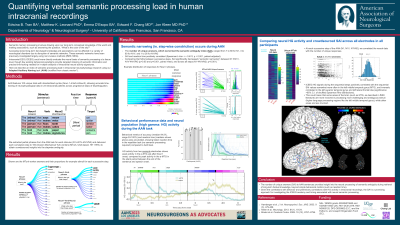Quantifying verbal semantic processing load in human intracranial recordings
Quantifying Verbal Semantic Processing Load in Human Intracranial Recordings
Friday, April 21, 2023

.jpg)
Edwina B. Tran, BA (she/her/hers)
Medical Student
University of California, San Francisco
San Francisco, California, United States
ePoster Presenter(s)
Introduction: Accessing stored long-term fact-based knowledge and associations can be affected in a variety of neurological disorders. The disrupted semantic networks underlying this have been investigated using non-invasive methods (fMRI, MEG), though intracranial EEG (ICEEG) could more directly evaluate their tissue-level neural basis. Yet, there are few existing behavioral paradigms for this purpose. Here we describe an index using an adapted classic auditory naming task (AAN) to quantify semantic processing load for human intracranial neurophysiology research.
Methods: The AAN task features standardized syntax (Noun1-->Verb-->Noun2) of sentence stimuli for step-wise time-locking of neurophysiological data and progressive disambiguation. We extracted partial phrases from the AAN task for each progressive sentence step (N1; N1-N1V; N1-N1V-N1VN2) and delivered to 100 Amazon Mechanical Turk workers (USA-based, HIT>95%) to obtain crowdsourced insights into stepwise ambiguity (semantic processing load).
Results: The number of unique answers (quantified and termed the semantic ambiguity index; SAI) ranged from 7-68 for N1, 3-60 for N1-V, and 1-26 for N1-V-N2 Comparing successive steps, SAI significantly decreased (semantic narrowing) across the three conditions (p < 0.05 and p< 0.001, paired t-test), and across the first and last condition (N1 vs. N1-V-N2; p< 0.001). SAI and reaction time correlated strongly (r=0.526, p < 0.001, Spearman). Preliminary ICEEG data showed high gamma (HG) signals during the sequential steps positively correlated with the sequential SAI values (>95% C.I. of shuffled data) in the left middle temporal gyrus, and inversely correlated with HG at sites in the left superior temporal and inferior frontal gyri.
Conclusion : Our crowdsourced SAI metric provides insights into the neural processing of ambiguity during retrieval of long-term factual knowledge. Given the correlations with behavior (reaction time) and preliminary intracranial HG activity findings, the SAI is a promising alternative for investigating the ICEEG anatomy and timing associated with the neural basis of semantic processing.
Methods: The AAN task features standardized syntax (Noun1-->Verb-->Noun2) of sentence stimuli for step-wise time-locking of neurophysiological data and progressive disambiguation. We extracted partial phrases from the AAN task for each progressive sentence step (N1; N1-N1V; N1-N1V-N1VN2) and delivered to 100 Amazon Mechanical Turk workers (USA-based, HIT>95%) to obtain crowdsourced insights into stepwise ambiguity (semantic processing load).
Results: The number of unique answers (quantified and termed the semantic ambiguity index; SAI) ranged from 7-68 for N1, 3-60 for N1-V, and 1-26 for N1-V-N2 Comparing successive steps, SAI significantly decreased (semantic narrowing) across the three conditions (p < 0.05 and p< 0.001, paired t-test), and across the first and last condition (N1 vs. N1-V-N2; p< 0.001). SAI and reaction time correlated strongly (r=0.526, p < 0.001, Spearman). Preliminary ICEEG data showed high gamma (HG) signals during the sequential steps positively correlated with the sequential SAI values (>95% C.I. of shuffled data) in the left middle temporal gyrus, and inversely correlated with HG at sites in the left superior temporal and inferior frontal gyri.
Conclusion : Our crowdsourced SAI metric provides insights into the neural processing of ambiguity during retrieval of long-term factual knowledge. Given the correlations with behavior (reaction time) and preliminary intracranial HG activity findings, the SAI is a promising alternative for investigating the ICEEG anatomy and timing associated with the neural basis of semantic processing.
